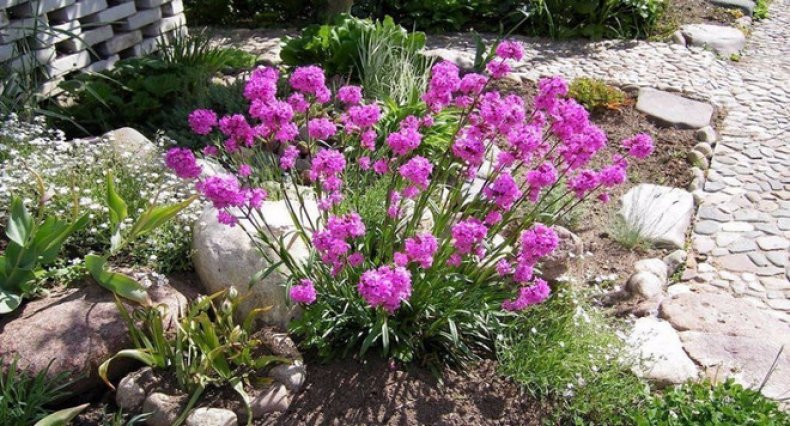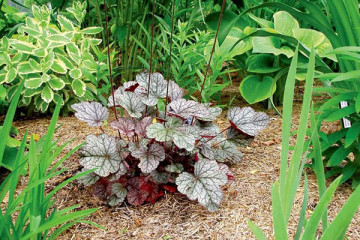Likhnis perennial - planting and care in the open field
Content:
- Description of perennial lychnis
- What types of lychnis exist: their description and characteristics
- Lychnis Chalcedonica, or dawn
- Lychnis viskaria
- Lychnis alpine
- Lychnis Arkwrightii
- Lychnis crown (Lychnis Coronaria, Lychnis Coriacea)
- Cuckoo adonis (Coronaria Flos-Cuculi), or cuckoo bloom (Lychnis Flos-Cuculi)
- Lychnis sparkling (Lychnis Fulgens)
- Lychnis Haageana
- Lychnis Jupiter (Lychnis Flos-Jovis, Coronaria Flos-Jovis)
- The varieties most popular with gardeners
- How perennial lychnis reproduces
- Features of care in the garden
- When and how it blooms
- Possible growing problems
- Use in landscape design
Perennial lychnis is a beautifully blooming plant that requires only little maintenance. It is able to harmoniously fit into an existing garden or park design. To choose the most suitable option, it makes sense for the gardener to learn more about what this plant is.
Description of perennial lychnis
This plant belongs to the Clove family. Perennial lychnis is widespread in the wild. It has been used in horticulture for several centuries. Due to its rich and vibrant color, it is also called adonis.
Plant characteristics
Lychnis flower is a perennial plant, various species of which do not exceed 1 m in height. The stem is rounded, slightly pubescent. The leaves are lanceolate, elongated. The flowers are bisexual, about 2 cm in diameter. This plant is grown in one place for no longer than 5 years.
What types of lychnis exist: their description and characteristics
More than 30 species of lychnis are known. The most popular of these among gardeners are described in more detail below.
Lychnis Chalcedonica, or dawn
In nature, it can be found in the European territory of Russia. Likhnis chalcedony is also distributed in the southern part of Siberia and Central Asia. The height of an adult bush is 80-100 cm. The leaf plates are ovoid-lanceolate. The inflorescences of chalcedony lychnis (dawn) have a corymbose-capitate form. They are made up of small flowers with a bright red color and petals that have two lobes. The diameter of the inflorescence reaches 10 cm.
Likhnis zorka has a high resistance to cold. The species has been known since 1561. The famous Maltese cross variety belongs to it, which is characterized by lush flowering and rich red color.
Lychnis viskaria
It grows in the south of the Siberian Plain, in Central Europe, in the North Caucasus. The height of the viscarius lychnis is 40-100 cm. The sticky upper part gave the plant another name - tar. The buds are crimson or white in color. Whorls consist of 6-7 pcs.
Lychnis alpine
The habitat of these flowers is the tundra and forest-tundra belts of the Scandinavian Peninsula, as well as the North American continent. Alpine lychnis can be found on the slopes of the Alps. The height of the bush is 15-20 cm. In the process of growth, leaf rosettes appear at the roots. Shoots are decorated with opposite leaves. The inflorescences have a panicle shape. Lychnis red has flowers of crimson or pink-red color.
Lychnis Arkwrightii
The height of the Arkwright lyhnis bush is 35-40 cm.Shoots and narrow leaves are burgundy in color. This bush produces a small number of orange-colored inflorescences. This species blooms from the last days of June to mid-August.
The most popular variety of this species is Vesuvius Lychnis. His leaves grow in the shape of a heart, and the number of inflorescences of red-orange color is larger and more luxuriant compared to the main species.
Lychnis crown (Lychnis Coronaria, Lychnis Coriacea)
In silver lychnis, the height of the bushes does not exceed 90 cm. Its inflorescences are racemose and loose. Most plants have pink flowers, but there are some that have white flowers. Planting and caring for crown lichen in the open field is not very difficult.
Cuckoo adonis (Coronaria Flos-Cuculi), or cuckoo bloom (Lychnis Flos-Cuculi)
This type of lychnis is distributed over most of the European continent. The height of his bush is 1 m. The leaves of the adonis are oppositely located. As they get closer to the crown, their length decreases. The petals of this species are pink. They are divided into four lobes, each of which hangs and twists a little.
Lychnis sparkling (Lychnis Fulgens)
It grows in Japan, in the Siberian taiga and in the Far East. The height reaches 40-60 cm. The leaves have an oblong ovoid shape. Red flowers are 4-5 cm in diameter. Their petals are divided into four parts.
Lychnis Haageana
The height of the bushes ranges from 40 to 45 cm. The leaf plates have an oblong-ovoid shape. Inflorescences are racemose. Each of them consists of 3-7 buds with a diameter of 5 cm. The petals look incised. There is one prong on each side. This species has high frost resistance.
Lychnis Jupiter (Lychnis Flos-Jovis, Coronaria Flos-Jovis)
This species grows on the slopes of the Alps. The height of Jupiter's lychnis is 80 cm. Its shoots are branched and densely leafy. There is a slight pubescence on the surface of shoots and leaf plates. The pale purple flowers are simple in shape. There are also terry and white-flowered forms.
The varieties most popular with gardeners
Below is a summary of the most popular varieties. They are actively used for garden and park design.
- Vesuvius. The flowers are bright orange. This variety has wide leaves that are shaped like a heart. Blooms from June to August.
- Rosetta. Refers to the type of viscaria. Lychnis Rosetta is a compact shrub with double flowers of intense crimson color.
- Maltese cross. This variety belongs to the species Chalcedony Lychnis. It got its name from the shape of the flowers, which look like a Maltese cross. It is characterized by a rich color and dense inflorescences.
- Smolka. This variety belongs to viskariya lychnis. Its name comes from the fact that the top of the plant is sticky. Has flowers of pink, white or crimson color. Flowering lasts from May to July.
- Adonis. The bush can grow up to a meter in height. The delicate carved flowers are pink. They are divided into four parts.
- Nana. This is a miniature bush up to 15 cm high. It belongs to the cuckoo adonis species. Small pink flowers.
- Alba. This variety belongs to the cuckoo adonis species. Flowers with a white color grow on its medium-sized bushes.
How perennial lychnis reproduces
For reproduction of perennial lychnis, seeds and cuttings are used. Lychnis can be grown by directly planting seeds in open ground or by growing seedlings first.
Growing from seeds
You can propagate this bush by directly planting seeds in the soil. If you use seedlings at the same time, then flowering should begin in the same season when planting was carried out.
Seeds begin to be planted for seedlings in March, and they should be planted in open ground in May.For planting, you need plastic containers with soil. Holes are made in the lower part through which excess moisture can flow.
To grow seedlings, you first need to place the seeds for stratification in the refrigerator for 15-30 days, wrapping them in a damp cloth. Then they are placed in fertile loose soil and start germination.
After 2-4 weeks, the root system will begin to develop. At this time, it is necessary to make a pick, planting the plants in separate containers. After 1-2 weeks, leaves will appear. After that, the plant is ready to be transplanted into open ground.
Cuttings
This propagation method is usually used for terry varieties. Cuttings are cooked in June. Their length should be 20-25 cm. Before germination, they are placed in a root solution for 30 minutes.
When planted in the ground, they are covered with foil. Cuttings are provided with regular watering. In August-September, the plants are planted in a permanent place.
Features of care in the garden
Perennial does not require much effort to grow. To get a lush bloom, you must follow the rules for caring for lichnis.
He needs good sunlight. A slight shadow is allowed. Lack of lighting will lead to the fact that flowering can become weak, insignificant. To prolong flowering, it is recommended to remove faded buds.
Watering
It is necessary to water lichnis only during periods of hot, dry weather, but make sure that there is no excessive moisture in the soil.
Priming
A fertile, slightly acidic soil with loose soil is suitable for the plant.
Top dressing
During one growing season, it is necessary to feed the bush 2-3 times. In early spring, he is given a mixture of carbamide, potassium sulfate and superphosphate.
During flowering, fertilizers should consist of superphosphate, agriculture-7, potassium sulfate. The prepared mixture is stirred in the proportion: 1 tbsp. spoon on a bucket of water.
When and how it blooms
The flowering time depends on the cultivation of the variety. Usually this period is one and a half months.
- Types of flowers. Flower shapes may vary depending on the variety and variety. Sometimes the petals are straight and sparse, in others they are split into two or four parts. There are also other types of them.
- Flower shapes. In most species of flowers, they gather in umbrella-shield inflorescences. But there are those in which they grow in small groups or individual flowers.
- Flowering period. It depends on the type of lychnis. Most varieties have flowers from June to August, and this time lasts for 1.5 months.
- Changes in care during flowering. At this time, the second of the dressings is produced during the season. It must contain all the elements necessary for the growth of flowers. There are no other changes in care.
Possible growing problems
Subject to the necessary care rules, lichnis practically does not get sick, the flower is also not susceptible to attack by pests.
When poorly cared for, the plant is susceptible to attack by aphids, leaf rollers and spider mites. To combat them, you need to spray with special preparations.
This plant is highly resistant to disease. Subject to the rules of care, it almost never gets sick.
If the plant does not have enough light, then this reduces the quality and abundance of flowering.
Use in landscape design
Lychnis looks spectacular when using group plantings against a background of green grass. Sometimes they plant it on the banks of reservoirs. Low-growing varieties look beautiful when decorating alpine slides or curbs for paths.
Perennial lychnis is able to decorate any garden or park. It looks impressive when used for a wide variety of purposes. Having learned more about this flower, the gardener can competently choose a suitable type and variety of this plant for himself.
























